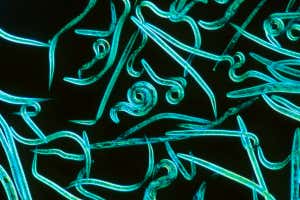Light micrograph of Caenorhabditis elegans, a soil-dwelling nematode. SINCLAIR STAMMERS/SCIENCE PHOTO LIBRARY
Nematode worms can distinguish between the molecules released by healthy and cancerous cells, and could one day be used in a cancer-detection system
Move over Fido. The next animal to help people by sniffing out cancer could be a microscopic worm.
Nematodes, also known as roundworms, are attracted to a compound released by lung cancer cells. When put into a small device, the nematodes (Caenorhabditis elegans) wriggle towards cancerous cells in preference to non-cancerous ones, early-stage work shows.
The approach has promise for being turned into a diagnostic test for lung cancer that could potentially use urine or saliva samples from people, says Nari Jang at Myongji University in South Korea.
Other researchers are trying to train dogs to detect cancer, but nematodes also have a good sense of smell, which is important for them to sniff out their food, usually bacteria or fungi. Previous research has shown they are attracted to urine from people with various kinds of cancer.
Cancer cells are biochemically different to non-cancerous cells in many ways. A compound called 2-ethyl-1-hexanol, which has a floral scent, seems to be what attracts the nematodes. “We guess that the odours are similar to the scents from their favourite foods,” Jang said in a statement.
Jang’s team has created a test kit comprising a small chip containing some of the 1-millimetre-long nematodes within a central chamber, connected to two wells at opposite ends from the chamber. The chip is placed on an agar plate, and a drop of liquid taken from a dish containing cancer cells is placed next to one well, with liquid from non-cancerous cells placed next to the other. In tests, more nematodes moved towards the cancer cell liquid over the course of an hour.
The tests showed that the nematode-containing device has an accuracy rate of about 70 per cent at detecting the presence of cancer cells. This isn’t high enough to be used as a medical test, but the accuracy is likely to improve if the nematodes are trained to respond to the floral scent, said Jang.
The idea isn’t as strange as it may sound, as nematodes have a surprisingly good memory for environmental cues like odours, says Lindy Holden-Dye at the University of Southampton, UK. “Worms are very easy to keep and don’t take up a lot of space,” she says. “In terms of what they can do they’re relatively sophisticated.”
The work was presented at the American Chemical Society meeting in San Diego this week.













